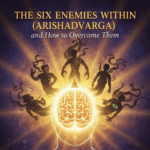Striking Similarities Between Ancient Indian and Greek Cosmologies
From the lofty peaks of the Himalayas to the sun‑drenched shores of the Aegean, two great civilizations looked up at the same sky and saw patterns, cycles, and archetypes that resonate across cultures. Though separated by thousands of miles and different languages, ancient Indian and Greek thinkers developed cosmologies that share remarkable motifs: creation from a primal void, elemental building blocks, divine hierarchies locked in cosmic conflict, vast world‑ages, and the interplay of myth, mathematics, and ritual. In this piece, let us trace these parallels – showing how each culture, in its own voice, echoes the other’s vision of time, space, and the human place within the cosmos.
1.Birth of the Cosmos: From Void to EggIndian Purāṇic Vision
In the earliest Purāṇas, before form and name existed, there was the undifferentiated waters –
an infinite, silent ocean without shore or bottom. Within that primal sea lay the golden womb‑egg, hiraṇyagarbha, the seed of all existence. From hiraṇyagarbha emerged Brahmā,
the creator, who split the waters into heaven and earth, set the sun, moon, and stars in motion, and established the laws (dharma) that govern every being. The cosmic egg remains a powerful symbol of latent potential: soundless, motionless, yet pregnant with every world to come.
Greek Orphic and Hesiodic Accounts
Greek cosmogony offers a parallel: out of Chaos – often depicted as a yawning void – came Gaia (Earth), Tartaros (the Underworld), and Eros (Desire). In Orphic fragments we read of a silver or golden cosmic egg, wrapped in cosmic wind, from which sprang Phanes (also called Protogonos), the radiant first-born whose emergence kindled the chain of divine birth. Just as hiraṇyagarbha contains Brahmā, the Orphic egg contains the seed of gods and mortals. Both images – egg on water, void yielding life – point to an archetypal intuition: creation issues from a unified, undifferentiated source.
Reflecting on the Parallel
When we contemplate these twin myths, we feel the same sense of awe that ancient poets must have felt. Two cultures, without direct contact in the earliest phases, painted startlingly
similar pictures of how “nothingness” yields “everything.” It suggests a universal impulse in the human mind: to imagine beginnings as emergence from unity, to see birth as the cracking of an egg or the parting of primeval waters.
2. Elemental Architectures: Five Roots and Five ElementsPañca‑Bhūta of India
By the later Vedic period and in Upaniṣadic thought, philosophers spoke of the pañca‑bhūta,the five great elements that underlie all manifestation:
-
- Prithvi (Earth): solidity, stability, support
-
- Ap or Jal (Water): fluidity, cohesion, transformation
-
- Tejas (Fire): energy, metabolism, illumination
-
- Vayu (Air): movement, respiration, life‑force
-
- ĀAkāśa (Sspace or Ether): the subtle field in which sound travels, the womb of all forms
These five weave together to form bodies, planets, and the vast fabric of the universe. None stands alone: earth needs space to expand, fire needs air to burn, water needs earth to pool.
Greek Four Elements and Aether
Empedocles, in the fifth century BCE, identified four “roots” (rhizomata) – earth, water, air, fire –
bound by the forces of Love (attraction) and Strife (repulsion). Aristotle later added a fifth,
aether, the incorruptible substance filling the heavens. Aether corresponds closely to Indian
ākāśa: a subtle medium pervading space, home to the stars, beyond the reach of decay.
Why the Convergence?
Both systems arise from keen observation of nature: solids, liquids, gases, heat, and the empty intervals between things. Each tradition intuited that beyond observable matter there must lie a subtler “space” or “quintessence” to account for sound, light, and celestial motions. Iit is telling
that when different minds look independently at rock, water, flame, wind, and sky, they naturally settle on the same five-fold schema. It speaks of the universality of elemental thinking.
3. Cosmic Ages: Yugas and the Ages of ManIndian Yuga‑Cycles
In the Purāṇas and Mahābhārata, time stretches in vast cycles called yugas. Four successive yugas – Satya (Golden), Tretā (Silver), Dvāpara (Bronze), and Kali (Iron)—span 4.32 million solar years in total. Each age sees a gradual decline of dharma (righteousness), from perfection in Satya Yuga to moral fragmentation in the present Kali Yuga. Yet at the end of the cosmic cycle, renewal begins: the seed of the next Satya Yuga emerges from the ashes of the previous Kali Yuga.
Hesiod’s Five Ages of Man
Hesiod, in his poem Works and Days, describes five Ages of Man: Golden, Silver, Bronze,
Heroic, and Iron. The Golden Age, ruled by Cronus, was a time of ease and virtue; the Silver and Bronze ages saw increasing toil and violence; the Heroic age – an interlude – brought demi‑gods and noble deeds; the Iron Age (the poet’s own time) is marked by hardship and
strife. Though the number of ages and their lengths differ, both traditions map moral quality onto cosmic epochs and see history as a descent from ideal virtue.
A Shared Moral Cosmology
One can sense a common human longing in these accounts: to explain why the world seems to slip from harmony into conflict. By locating morality within cosmic time, both Indians and Greeks turned history into a moral play. We find comfort in knowing that decay is part of a larger cycle – that today’s darkness need not be the final word. As beings living in an era of rapid change, we can find solace in the yuga model’s promise of renewal beyond decline.
4. Divine Struggles: Devas vs. Asuras and Olympians vs. TitansIndian Divine Conflicts
The Purāṇas teem with battles between Devas (gods of light and order) and Asuras (sometimes “demons,” often anti‑gods). These struggles are not absolute good versus evil but contests over power, knowledge, and cosmic balance. Indra’s slaying of Vṛtr a, the dragon of drought, releases the waters and restores fertility. Viṣṇu’s avatars descend to vanquish Asura‑tyrants and re-establish dharma.
Greek Titanomachy and Gigantomachy
In Greek myth, the Titans – elder children of Gaia and Uranus – once ruled but were overthrown by the Olympian gods in the Titanomachy. Later, the Olympians fought Giants in the Gigantomachy to secure their reign. Zeus’s victory over his father Kronos parallels Indra’s victory over Vrtra: heaven’s order is won through slaying a primeval foe.
Cosmic Order through Conflict
Both cultures envision divine rule as contingent on heroic struggle. Order (ṛta or reet) is not a given; it must be won and maintained, just like our own social and personal orders require
constant effort against entropy. The myths teach that vigilance and courage are perennial necessities, whether one battles a dragon or overthrows a dethroned god.
5. Philosophical Dualities and Non‑DualitiesSāṅkhya and Platonic Forms
Sāṅkhya philosophy posits two ultimate realities: puruṣa (pure consciousness as also the unmanifest universe) and prakṛt (primordial matter as also the manifest universe). Prakṛt i, under the influence of three guṇas (qualities) – Tamas, Rajas and Sattva – evolves into the manifold world; puruṣa remains the detached observer. Reality unfolds as a dialogue between these principles.
Plato’s metaphysics draws a similar distinction: the realm of unchanging Forms (Ideas) versus the sensible world of flux and appearance. The Form of the Good illuminates the intelligible
realm, while the material world is its imperfect reflection. In both systems, a split between changeless reality and changeful manifestation structures the entire philosophical vision.
Advaita Vedānta and Neoplatonism
Advaita Vedānta goes beyond dualism to assert that Brahman alone is real, and the world‑multitude is māyā (illusion). Liberation lies in realizing the non‑duality of Ātman (Self) and Brahman.
Neoplatonism, as articulated by Plotinus, describes emanations from the One: first Nous (Divine Mind), then World Soul, finally the material world. The soul’s return to the One through contemplation mirrors the Vedāntic path of jñāna ((knowledge). Both traditions envision a single source beyond all plurality and a spiritual journey back to that source.
Bridging Thought and Experience
When we contemplate these parallels, we can feel the same core insight: beneath diversity lies unity. Whether called Brahman or the One, the ultimate reality transcends time, space, and multiplicity. Philosophy becomes not just abstract speculation but an invitation to awaken to that unity.
6. Astronomy: Mapping the HeavensIndian Siddhāntas
From rĀyabhaṭ a (5th century CE) to Brahmagupta (7th century CE), Indian astronomers produced sophisticated models of planetary motion, eclipse prediction, and trigonometric tables. They measured the sidereal year within minutes of modern values, calculated sine values to high precision, and framed the motions in geometric schemes of epicycles (manda and śīghra
corrections).
Greek Observers
Greek scholars such as Hipparchus (2nd century BCE) compiled star catalogs, discovered precession of the equinoxes, and developed the geometry of deferents and epicycles in Ptolemy’s Almagest (2nd century CE). Their trigonometric innovations (the chord table) parallel Indian sine tables in purpose and precision.
Convergent Solutions
Although working independently, both traditions confronted the same observational data: the wanderings of planets, the rhythmic return of eclipses, the shifting backdrop of stars. Epicycles in India and Greece are convergent inventions—geometric devices to reconcile circular motion with empirical irregularities. It is striking how similar mathematical creativity blooms wherever keen observers meet baffling data.
7. Ritual and Symbol as Cosmic TechnologyVedic Yajña
In Vedic culture, the fire‑ritual (yajña) is a microcosm of creation. The altar’s geometry encodes cosmic maps: its bricks correspond to days, months, and lunar mansions. Mantras recited at precise muhūrtas align human chants with planetary rhythms. Through yajña,the sacrificer participates in the ongoing maintenance of rta, the world‑order.
Greek Mystery Cults
Eleusinian and Orphic mysteries use initiation rites, sacred chants, and symbolic objects (the kykeon potion, the ear of grain, the cosmic egg) to effect a participatory union with divine cycles of death and rebirth. Initiates undergo a symbolic descent into underworld darkness and emerge into light – mirroring Persephone’s return and the renewal of nature.
Ritual as Alignment
Both traditions treat ritual as technology: a set of procedures that align microcosm with
macrocosm. Whether stirring the sacrificial ladle or descending into a temple’s inner chamber, ritual practitioners seek to bridge human time with cosmic time. Our modern day rituals – lighting
a lamp at dusk, ringing a bell at dawn – are a distant echo of these ancient technologies, reminding us that ceremony anchors us in the rhythms of nature and cosmos.
8. Moral Dimensions of CosmologyDharma and Cosmic Law
In Indian thought, dharma is more than personal duty; it is the principle that upholds the
universe. When gods intervene to restore dharma, they re‑establish the harmony that allows life to flourish. Cosmic justice is woven into time’s fabric: every action (karma) bears fruit in future births or ages.
Greek Justice and Moirai
Greek cosmos is likewise moral. The Moirai (Fates) spin, measure, and cut the thread of life. Nemesis punishes hubris; Zeus upholds justice (dike). Human fortunes rise and fall according to divine law. The tragedy of Oedipus or the sufferings of Prometheus remind us that cosmic order demands respect for limits.
Ethics Woven into Structure
In both worlds, cosmology is not amoral but carries ethical imperatives: live in balance, honor limits, accept cycles of rise and decline. It is deeply meaningful: to know not only the cosmos but also to know how to live within it. Science without ethics can become destructive; myth
without moral weight becomes empty fable. These ancient systems bind knowledge and virtue together.
9. Cross‑Cultural Encounters and LegacyFrom Alexander’s campaigns in the fourth century BCE to the Silk Road exchanges of the early centuries CE, Greek and Indian thinkers came into contact. Greco‑Bactrian kingdoms in Afghanistan facilitated the fusion of art during the Gandhāra era, where astronomy (exchange of texts), and philosophy (early Buddhist dialogues interacted with Hellenistic thought) suffused each other.
We find Greek similes in the Buddhist Milindapañha (dialogue of King Menander) and Indian references to the “Yavana” (Greek) philosophers. While direct lines of influence are debated, the resonance is clear: these cultures enriched each other and bequeathed to later Islamic and European scholars a blended heritage of geometry, metaphysics, and myth.
10. Contemporary Reflections
Today, scientists model the universe in terms of space, time, dark matter, and quantum fields—concepts not at all alien in detail to ancient thinkers. Perhaps the ancient sciences were more intuitive and the present day ones are more factual, yet the basic premises of yore stand tall and relevant. Space is still a subtle medium (ākāśa,aether) and time still flows in cycles (yugas, cosmic ages) as each scientific advancement invites fresh dialogue into the ancient wisdom. We may see echoes of cyclical cosmologies in modern bouncing‑universe theories; we see the quantum vacuum as a modern counterpart of ākāśa.
Philosophically, the split between observer and observed remains a live issue in quantum mechanics – recalling Sāṅkhya’s puruṣa – prakriti dualism and Vedānta’s call to transcend subject–object divides. Ritual and symbol have their counterparts in scientific practice:
measurement procedures, reference frames, calibration rituals.
Conclusion: A Shared Human Adventure
When we weave together Indian and Greek cosmologies, we are struck less by who influenced whom, more by the shared human yearning to understand origins, structure, and destiny. Both traditions:
-
- Begin in paradox—void and pregnant, chaos; yet orderely.
-
- Identify fundamental “elements” to explain diversity.
-
- Envision cosmic ages suffused with moral meaning.
-
- Stage divine struggles that mirror human challenges.
-
- Develop precise mathematical models to chart the heavens.
-
- Employ ritual and symbol as bridges between earth and sky.
These parallels remind us that despite differences of language and culture, our ancestors grappled with the same great questions: Where did we come from? What are we made of? How does the cosmos maintain order? How should we live in its vast cycles? Their answers – part mystic, philosophical and part scientific, empirical – form twin constellations in the history of thought.
Today’s world owes its standing to both – Indian and Greek – these pioneering giants. We can draw inspiration from their bold imagination, their rigorous observation, and their seamless blending of science, art, and spirituality. In doing so, we honor a shared legacy: the human adventure of mapping heaven and earth, charting time and space, and seeking our place in the grand cosmic story.
Whether you find yourself stirred by the image of the golden egg, the logic of Epicycles, the chant of a mantra, or the geometry of a temple floor, know that you join a lineage of seekers spanning continents and millennia. Their striking similarities remind us: beneath every sky, the human heart beats with the same questions and the same awe. We may well think of ourselves as different from each other, but in the eternity and vastness of nature, we are simply seekers of the same truths.





